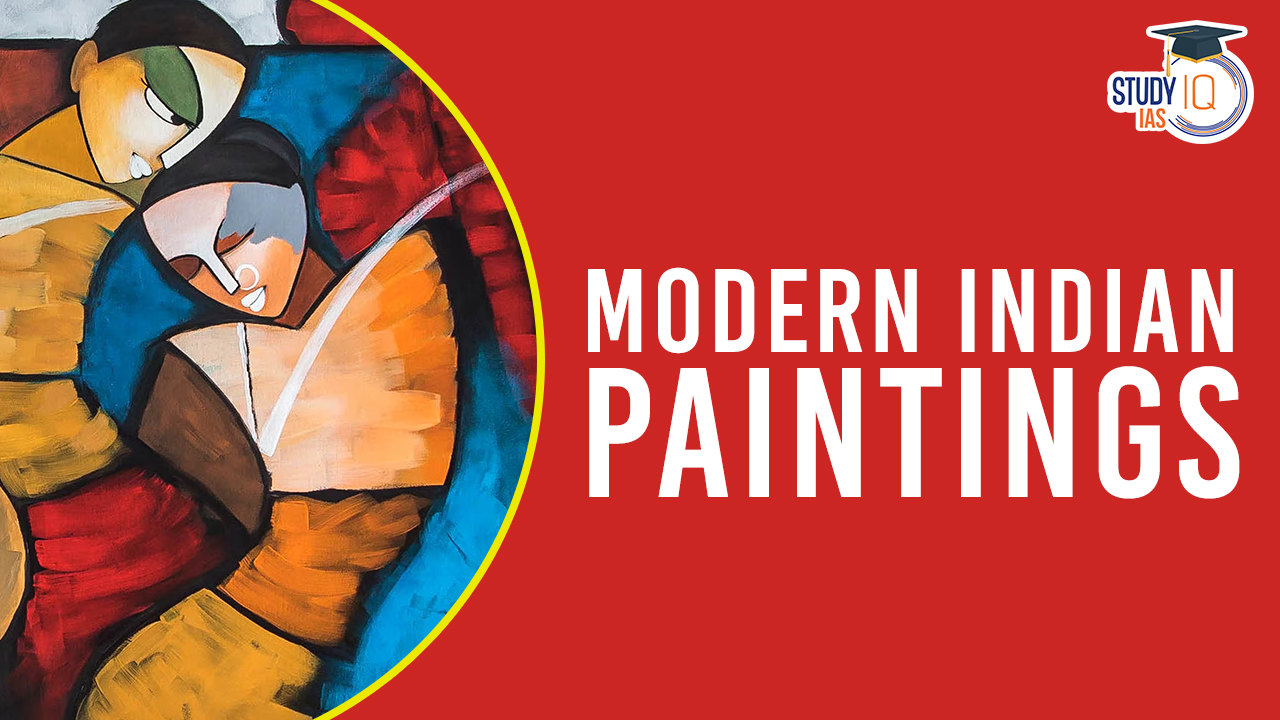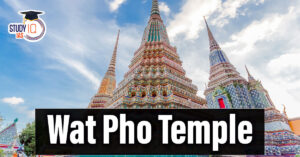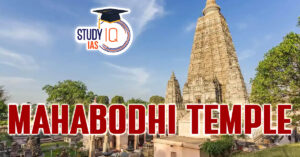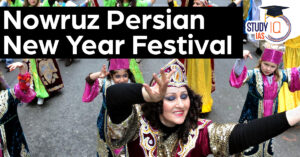Table of Contents
Modern Indian paintings, influenced by a rich artistic heritage, showcase a diverse tapestry of styles and themes. By the late 19th century, Indian painting, an extension of miniature traditions, faced decline, finding limited expression in ‘Bazaar’ and ‘Company’ styles. Raja Ravi Varma, influenced by Western naturalism, emerged as a key figure. Abanindranath Tagore countered this decline, giving rise to the Bengal School of Painting marked by nostalgia. Post-WWII, India’s independence prompted profound political and cultural shifts, challenging artists to navigate new realities.
This period spurred a journey of modernization, with artists embracing global influences, notably from the Western world, and diverse styles like impressionism and expressionism.
We’re now on WhatsApp. Click to Join
Evolution of Modern Indian Paintings
- Late 19th Century Decline:
- Indian painting, an extension of miniature traditions, declined towards the late 19th century.
- Limited expression in the ‘Bazar’ and ‘Company’ styles and various folk arts persisted.
- Introduction of Western Naturalism:
- Raja Ravi Varma was a key proponent of the newly introduced Western concept of naturalism.
- Abanindranath Tagore’s Initiative:
- Abanindranath Tagore aimed to counter the cultural decline.
- Under his leadership, a new school emerged, initially nostalgic and romantic.
- It became known as the Bengal School of Painting, also called the Renaissance School or the Revivalist School, lasting over three decades.
- Post-World War II Changes:
- The end of World War II brought unprecedented political and cultural changes.
- This period coincided significantly with India’s independence, offering new opportunities.
- Modernization and Confrontation:
- Artists embarked on a path of modernization and engagement with the broader world.
- Confrontation with the Western World led to far-reaching consequences.
- Adoption of Western Ideas:
- Artists absorbed change, adopting ideas such as impressionism, expressionism, or post-expressionism.
- Contemporary Indian Painting:
- Technique and method gained new significance.
- Form began to be regarded as a separate entity, often subordinating content.
- Rise of Individualism:
- The predominant artist ideology shifted towards individualism.
- This presented a new challenge: a lack of real rapport between the artist and the people.
Colonial Painting: A Fusion of Styles
During the colonial period in India, a unique and hybrid painting style emerged, epitomizing the cultural amalgamation between Indian and European influences. This distinctive art form, known as “Company Paintings,” was a result of the convergence of Rajput, Mughal, and various Indian painting styles with European artistic sensibilities.
Influences and Origins
- Hybrid Style: Company Paintings seamlessly blended Indian artistic traditions with European styles and techniques.
- British Company Officers: The paintings were often a product of collaboration between British East India Company officers and Indian painters trained in traditional styles.
- European Sensibilities: The painters, schooled in Indian techniques, incorporated the European sensibilities of their British employers into their artwork.
Distinctive Features
- Watercolor Technique: A notable characteristic of Company Paintings was the use of watercolor, setting them apart from traditional Indian paintings.
- Linear Perspective and Shading: Influenced by European techniques, these paintings featured elements of linear perspective and shading, showcasing a departure from the more flat and stylized traditional Indian art.
Regional Birthplaces
- Art Hubs: Kolkata, Chennai, Delhi, Patna, Varanasi, and Thanjavur emerged as prominent centers for the development of Company Paintings.
- Diverse Influences: Each region contributed unique elements to the style, reflecting the diverse cultural and artistic heritage of India.
Patronage and Themes
- British Patrons: Notable figures such as Lord Impey and Marquess Wellesley were patrons of the Company Painters.
- Exotic Subjects: Many paintings depicted India’s “exotic” flora and animals, catering to the fascination of the British with the country’s diverse and unfamiliar natural environment.
Popularity and Legacy
- 20th Century Popularity: Company Paintings enjoyed popularity until the early 20th century.
- Transition Period: As India underwent significant socio-political changes, the popularity of this style declined, giving way to newer forms of artistic expression.
The legacy of Company Paintings lies in their representation of a unique cultural exchange, capturing a period when Indian artists adapted their traditional techniques to accommodate European tastes. This fusion not only resulted in aesthetically pleasing artworks but also serves as a historical testament to the intricate interplay of cultures during India’s colonial era.
Bazaar School: A Fusion of European and Indian Influences
The Bazaar School, emerging during the European encounter in India, marked a distinct departure from both traditional Indian art and the earlier Company Paintings. This school amalgamated European and Indian methods, creating a unique visual language that reflected the impact of cross-cultural interactions.
Characteristics of the Bazaar School
- European and Indian Fusion:
- Unlike Company Paintings, the Bazaar School seamlessly combined European and Indian artistic methods and themes.
- This fusion reflected the evolving cultural dynamics during the European presence in India.
- Influence of Roman and Greek Culture:
- The Bazaar School drew inspiration from Roman and Greek cultures rather than traditional Indian influences.
- Painters in this school were compelled to imitate Greek and Roman statuary, leading to a distinctive blend of styles.
- Popular in Bengal and Bihar:
- The Bazaar School found prominence in regions such as Bengal and Bihar, where artists embraced the fusion of Western and Indian elements.
- Themes Beyond Indian Culture:
- Unlike traditional Indian art, the Bazaar School delved into themes inspired by Greco-Roman history, showcasing a departure from indigenous cultural motifs.
- Paintings often depicted everyday bazaars in India, incorporating a European backdrop into the scenes.
- Courtesans and British Officials:
- One of the most renowned genres within the Bazaar School featured depictions of Indian courtesans dancing before British officials.
- These paintings provided a visual narrative of the social interactions and dynamics during the colonial period.
- Religious Themes with Restrictions:
- The Bazaar School also ventured into religious themes, but with notable restrictions.
- Depicting figures of Indian Gods and Goddesses with more than two axes or featuring elephant faces like Lord Ganesha’s was forbidden.
- These restrictions stemmed from the adherence to European notions of a natural human figurine, highlighting the influence of Western aesthetics.
Legacy and Significance
- The Bazaar School’s legacy lies in its representation of a unique cultural fusion during a transformative period in India.
- It serves as a visual record of the complex interactions between European colonial powers and Indian artistic traditions.
- While influenced by European elements, the Bazaar School maintained its roots in Indian subject matter, contributing to the diverse tapestry of Indian art history.
The Bazaar School stands as a testament to the dynamic nature of artistic expression during a period of intense cultural exchange, showcasing how Indian artists navigated and adapted to the evolving influences brought about by the European encounter in India.
Raja Ravi Varma: Pioneer of Indian Contemporary Painting
Raja Ravi Varma stands as a titan in India’s artistic legacy, celebrated as one of its most gifted painters. Often hailed as the trailblazer of contemporary painting, his contributions are marked by a harmonious fusion of South Indian artistry with Western techniques, earning his school the moniker “modern” due to the prevalent influence of Western motifs.
Unique Fusion of Styles
- Raja Ravi Varma’s distinctiveness lay in his adept combination of South Indian artistic elements with Western color palettes and stylistic techniques.
- This synthesis created a novel aesthetic that reflected both his cultural roots and a progressive embrace of global influences.
Raphael of the East
- Renowned for his bright and lively brush strokes, Raja Ravi Varma earned the epithet “Raphael of the East,” drawing parallels with the renowned Italian Renaissance artist Raphael.
- His paintings, characterized by vivid colors and an astonishing lifelike quality, showcased a mastery that transcended regional boundaries.
Origin and Influences
- Hailing from the state of Kerala, Raja Ravi Varma’s artistry was deeply rooted in the rich cultural milieu of South India.
- He skillfully integrated Western techniques into his works, a reflection of the changing artistic landscape influenced by global trends.
Notable Works
- Raja Ravi Varma’s oeuvre includes iconic masterpieces such as “Lady in the Moonlight” and “Mother India,” which exemplify his ability to capture emotion and beauty with remarkable finesse.
- His depictions of scenes from the epic Ramayana, notably the painting titled ‘Ravana Kidnapping Sita,’ garnered national acclaim for their narrative richness and visual grandeur.
National Acclaim
- The artist’s paintings, with their evocative storytelling and technical brilliance, earned him widespread recognition and national acclaim.
- Raja Ravi Varma’s impact on the Indian art scene extended beyond his lifetime, influencing subsequent generations of artists.
Legacy of Modern Indian Art
- Raja Ravi Varma’s legacy endures as a cornerstone of modern Indian art, transcending regional and cultural boundaries.
- His pioneering efforts laid the foundation for the evolving landscape of contemporary Indian painting, blending tradition with innovation.
Bengal School of Art
The Bengal School of Art, commonly known as the Bengal School, emerged as a significant art movement and style in Indian painting during the early 20th century, flourishing in Bengal and across the Indian subcontinent under British rule.
Emergence of the Bengal School
During the British Raj, traditional Indian painting styles faced a decline in popularity, failing to resonate with the preferences of British collectors. European painting techniques and Company Paintings, catering to British sensibilities, gained prominence. However, these works simplified Indian subjects into exotic representations, devoid of cultural depth. In response, the Bengal School emerged, drawing inspiration from Mughal, Rajasthani, and Pahari styles to present elegant scenes of authentic Indian traditions and daily life.
Main Features of the Bengal School of Painting
- Rooted in Indian Traditions:
- The Bengal School is deeply rooted in Indian traditional styles, focusing on subjects that reflect Indian culture. Themes such as ‘Mahakali,’ ‘Shiva Parwati,’ and ‘Krishna and Gopis’ showcase the school’s commitment to Indian mentality.
- Influence from Ajanta Art:
- Influenced by Ajanta Art, the Bengal School exhibits qualities like rhythm, grace, and harmony, mirroring the characteristics of this ancient Indian artistic tradition.
- Linear Delicacy:
- The lines in Bengal School paintings resemble the delicate and rhythmic lines found in Ajanta Paintings, contributing to the overall aesthetic appeal.
- Softness and Rhythm in Figures:
- Bengal School figures exhibit a soft and graceful quality, avoiding harshness. The paintings convey a sense of delicacy and rhythmic flow, providing a visually pleasant experience.
- Beautiful Colour Scheme:
- The Bengal School employs an attractive colour scheme, utilizing the wash technique to create subdued and harmonious colors. The palette avoids overly bright and gaudy tones.
- Influence of Mughal and Rajasthani Schools:
- Elements of the Mughal and Rajasthani painting traditions influence the Bengal School, adding diverse artistic dimensions to its creations.
- Light and Shade Techniques:
- The softness in Bengal School paintings is achieved through a mastery of brilliant light and shade techniques, contributing to the overall visual appeal.
- Impressive and Indian Subject Matter:
- The subject matter of the Bengal School is diverse and distinctly Indian, encompassing historical, religious, literary, and cultural themes that contribute to the impressive and authentic character of the artwork.
Cubist Style of Painting in India
The Cubist style of painting in India drew inspiration from the European Cubist movement, where artifacts were deconstructed, analyzed, and then meticulously reassembled. This method, characterized by fractured perspectives and abstract forms, aimed to achieve an ideal balance between line and color.
M.F. Hussain – Pioneer of Indian Cubism
One of India’s most celebrated cubist artists was M.F. Hussain, renowned for his ‘Personification of Romance’ series. His distinctive approach involved the use of abstract art forms, with a particular emphasis on the subject of horses. For Hussain, the horse symbolized fluidity of motion, and he ingeniously conveyed abstract meanings through this recurring motif.
Progressive Artists Group
In 1947, the Progressive Artists Group garnered attention for its bold exploration of advanced and daring topics, blending them with softer, more abstract elements. Although the members had diverse styles, they were collectively inspired by European Modernism. Founded by Francis Newton Souza, the group included prominent artists like S.H. Raza, H.A. Gade, Ara, and others.
M.F. Hussain’s Role in the Progressive Artists Group
M.F. Hussain, already a notable cubist painter, became a member of the Progressive Artists Group, adding his unique perspective to the collective. The group’s first art show in 1948 received patronage from Mulk Raj Anand, contributing to their initial success.
Evolution of the Progressive Artists Group
Since their inception, the Progressive Artists Group has evolved into a major collective, establishing numerous galleries in prominent art hubs like Delhi and Mumbai. Their work reflects a fusion of diverse influences, from traditional Indian art to global modernism, creating a unique and dynamic artistic discourse.
Legacy and Impact
The Cubist style, as interpreted by Indian artists like M.F. Hussain within the Progressive Artists Group, left an indelible mark on the trajectory of Indian modern art. Their bold experimentation with form and content, rooted in global modernist movements, contributed to the evolution of a distinct Indian modernist identity.
Modern Indian Paintings UPSC
The evolution of modern Indian paintings witnessed a decline in the late 19th century, followed by the introduction of Western naturalism spearheaded by Raja Ravi Varma. Abanindranath Tagore’s initiative led to the emergence of the Bengal School of Painting, fostering a nostalgic and romantic style. Post-World War II, artists confronted unprecedented changes coinciding with India’s independence, fostering a path of modernization. The adoption of Western ideas, especially by the Progressive Artists Group, marked a transformative phase. Meanwhile, the Cubist style, championed by M.F. Hussain, left a lasting impact, blending Indian and global influences. The Bengal School, with its roots in tradition, and the Progressive Artists Group, pushing artistic boundaries, remain influential legacies in Indian art.


 PM Modi visits Wat Pho Temple in Bangkok
PM Modi visits Wat Pho Temple in Bangkok
 Mahabodhi Temple Complex at Bodh Gaya
Mahabodhi Temple Complex at Bodh Gaya
 Nowruz 2025 Persian New Year Festival
Nowruz 2025 Persian New Year Festival





















